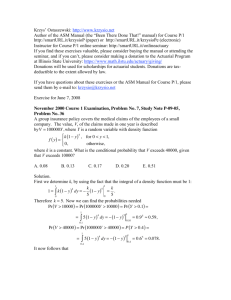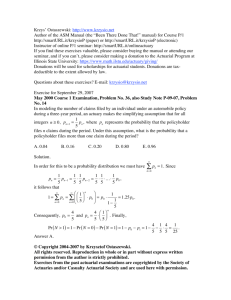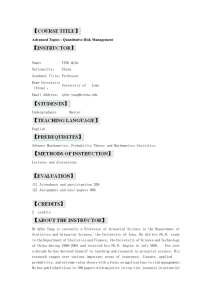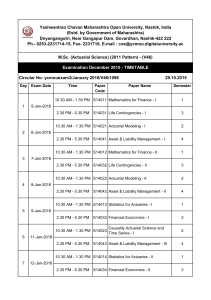Inside the Black Box: Adjustments and Considerations for Public Policy Proposals
advertisement
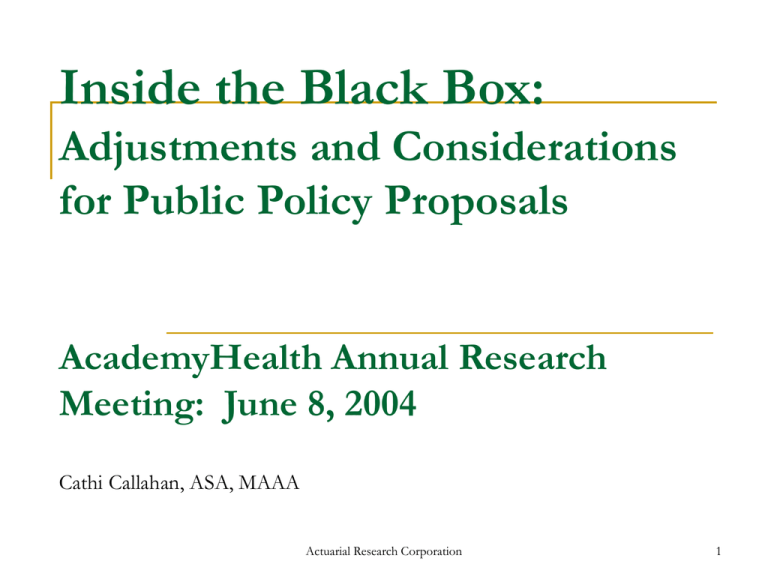
Inside the Black Box: Adjustments and Considerations for Public Policy Proposals AcademyHealth Annual Research Meeting: June 8, 2004 Cathi Callahan, ASA, MAAA Actuarial Research Corporation 1 Adjustments and Considerations Issues of Pricing a Particular Plan Plan and population specific adjustments Issues of Total Cost of the Proposal Who benefits and how Actuarial Research Corporation 2 Adjusting for Public Policy: Pricing a Plan Starting population / starting costs Benchmarking Adjusting for particular plan / program Adjusting for population targeted Adjusting for lack of prior insurance Adjusting for who takes up insurance Actuarial Research Corporation 3 Where We Start People with insurance Private sector (this discussion) Public sector Medicaid SCHIP Medicare Their costs Costs of the group over a given time interval Costs of a person / person’s group over a longer period Actuarial Research Corporation 4 Premiums Where do we get starting premiums from? Industry data Survey data Biased by clients Biased by respondents Public program data Often dated / limited release Actuarial Research Corporation 5 Adjusting the Premium: Benchmarking Why Benchmark? Need to control to federal or state specific data Need to control level and / or trend Actuarial Research Corporation 6 Adjusting the Premium: Plan Richness What is the particular plan being proposed vs. starting data? “Actuarial valuation” Adjusting benefits of a specific reform plan vs. what is perceived as “average” (or starting point) coverage Actuarial Research Corporation 7 Adjusting the Premium: Population Who participates Different underlying costs by different populations Prior Insurance Age Actuarial Research Corporation 8 Adjusting the Premium: Induction Changing spending habits based on richness of new plan Increased spending for previously uninsured Increased or decreased spending for previously insured (plan dependent) Actuarial Research Corporation 9 Induction Effects (the required actuarial slide) Total spending for covered services is assumed to be proportional to: 1/(1 + *P) where is the "induction parameter" and P is the average fraction of the cost of services paid by the consumer. Actuarial Research Corporation 10 Adjusting the Premium: Selection Persons who participate may be above average risk (cost) How does this happen? Not all eligible participate Who does? Some average risk Some above average risk Not all experience selection Effects of subsidy schemes Spread selection effects across entire group of participants Actuarial Research Corporation 11 Selection Effects: Examples Use claims distributions to look at differential assumptions 25% participating vs. 10% participating The more who participate, the less the effect on the overall group Actuarial Research Corporation 12 Selection Effects: Examples Example 1 25% participation in an uninsured subgroup draws: Half (12.5%) from top of distribution Half (12.5%) from rest of distribution For Children, this is a 375% increase If subgroup were 10% of total population, this has effect of 1.275 Example 2 10% participation in an uninsured subgroup draws: 40% (.4*.1 = 0.04) from top of distribution 60% (.6 * .1 = 0.06) from rest of distribution For Children, this is a 836% increase If subgroup were 10% of total population, this would be increase of 1.736 Actuarial Research Corporation 13 Example of Premium Calculation Source information: Kaiser Project on Incremental Health Reform, Kaiser Family Foundation Premiums calculated for the proposal detailed in: “Extending Health Insurance Through Tax Credits”, Mark Pauly, October 1999. Actuarial Research Corporation 14 Example of Premium Calculation Pauly Plan: Income Related Tax Credits Tax credit covering full cost for under 150% of poverty Sliding scale to no credit at 500% poverty Insurance purchased in current market Reconciled on tax return Choice of this or tax exclusion for ESI Actuarial Research Corporation 15 Example of Premium Calculation Starting point: Average market premiums for children, 2005 terms $2107 overall Based on $1139 per child in 1998, inflated by NHE per capita change in private health insurance of 1.85 Actuarial Research Corporation 16 Example of Premium Calculation: Population Adjustment Participation by: Uninsured children Non-group children ~10% of participants at 0.5 * non group cost ~90% of participants at 1.0 * non group cost No participation by Medicaid or ESI kids $2002 per child Actuarial Research Corporation 17 Example of Premium Calculation: Induction adjustment Previously uninsured only Proxy utilization replacing actual induction equation 40% increase for the uninsured Approximately 2% overall $2042 per child Actuarial Research Corporation 18 Example of Premium Calculation: Induction adjustment (alternative calculation) Induction equation: Q= 1/(1 + *P) α = 0.555 Uninsured: P = 1.0 (Person pays 100%) Q = 1 / (1 + (.555 * 1) ) = 0.643 Insured: P = .2 (Person pays 20%) Q = 1 / (1 + (.555 * .2)) = 0.900 0.900 / 0.643 = 1.40 Actuarial Research Corporation 19 Example of Premium Calculation: Selection For those not fully subsidized Children > 150% of poverty Selection of 1.67 on partially subsidized uninsured Use 1.00 for all fully subsidized children Use 1.00 on those with current coverage Coverage does not change Spread over all children who participate $2124 per child Actuarial Research Corporation 20 Summary of Adjustments Starting per child cost: Population adjustment: Induction assumption: Selection assumption: $2107 $2002 $2042 $2124 Final premium: $2124 Actuarial Research Corporation 21 Considerations of Public Policy Plans Who benefits The already insured who may not have access to current subsidies The uninsured Long vs. short term uninsured Children, parents, working adults How we spend tax dollars New vs. existing coverage Actuarial Research Corporation 22 Issues with Tax Credit Proposals Availability of Credit Prospective vs. Retrospective Cost of covering All recipients of credits vs. Covering newly covered Usually a small percentage with retrospective credits Actuarial Research Corporation 23


